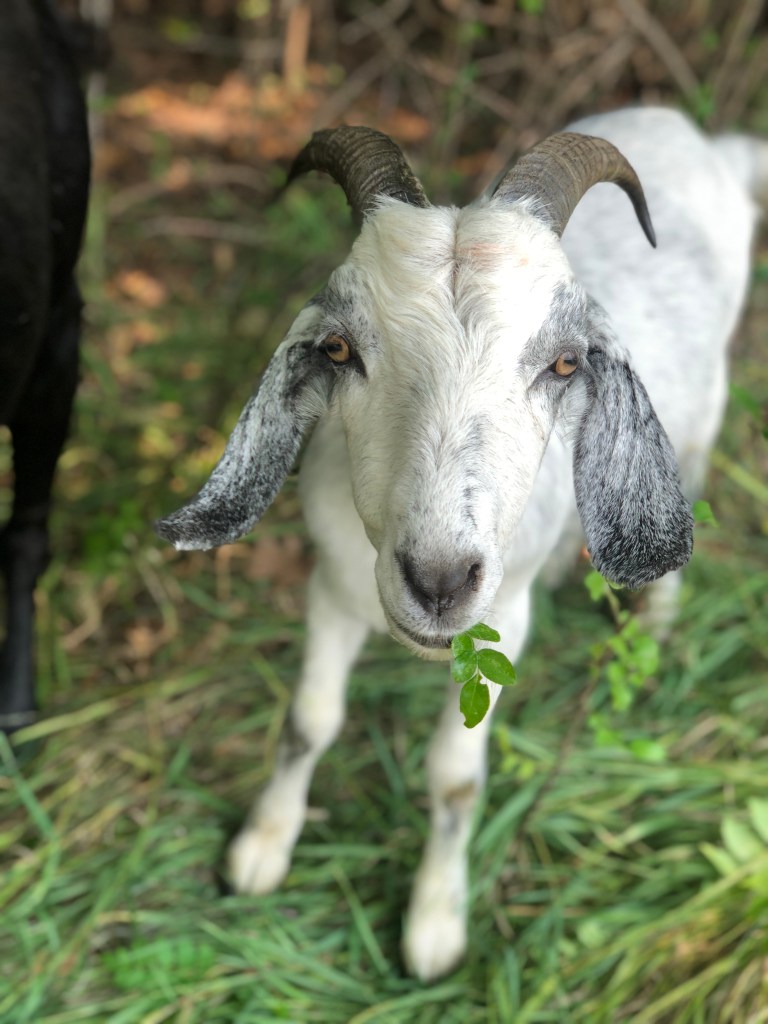What has four legs, eats everything in sight, loves yoga (apparently), and is guaranteed to make you smile?

Two years ago, my son and I set out on a geocaching adventure in Cottage Grove Ravine Regional Park, only to find ourselves separated from the hidden cache by a long wire fence and fifty bleating goats. The goats had been brought in to clear out invasive plants, including buckthorn, garlic mustard, and honeysuckle, and were frolicking and eating, unperturbed, around the warty tree that we sought.
In fact, goats are an effective and loveable tool in the war against invasive species.

One common invasive – buckthorn – has taken over thousands of acres of woodlands in Minnesota and Wisconsin. This invasive shrub from Europe chokes out native flowers and shrubs that provide food and habitat for birds and wildlife, and threatens the long-term survival of oaks, maples and other hardwood trees. It leafs out early in the spring and retains green leaves late into the fall, giving it a competitive advantage, and its purple berries have a diuretic quality, which leads birds to spread its seeds more quickly. Worst of all, it possesses a maddening ability to re-sprout if it is cut down, with even more branches than before.
Garlic mustard is another pernicious invader that greens up early in the spring and can quickly take-over a forest understory. Its roots exude chemicals that alter the soil and discourage mycorrhizal fungi and native plants from growing nearby, and it produces prolific amounts of seeds that readily stick to shoes and wildlife. Even more frustrating, garlic mustard has an uncanny tendency to sweep in on the heels of buckthorn, filling in the forest floor after buckthorn is cut and cleared.

You and I might find buckthorn and garlic mustard to be frustrating, but goats will eat these plants with glee. Goats have special enzymes in their guts that enable them to eat plants that are poisonous to other animals and they adore the leaves of woody shrubs like buckthorn, honeysuckle, and prickly ash.
What can you do if you have no goats of your own?
A few small businesses raise and rent out goats to parks and private landowners for invasive species management. The Munch Bunch (www.munchbunchgoats.com), Goat Dispatch (www.goatdispatch.com), Diversity Landworks (www.diversitylandworks.com), and Goats on the Go (www.goatsonthego.com) are four local options. Conversely, if you already raise goats and want to put your furry friends to good use, you can apply to become an affiliate of Goats on the Go and rent your goats out to other people.

To learn more about managing invasive species with goats, join the East Metro Water Resource Education Program, Washington County Parks, and The Munch Bunch for an outdoor workshop on Tuesday, May 3, 6-7pm at Big Marine Park Reserve. (The 1st Tuesday of every month is free admission to Washington County Parks, so no parking permits are required.) Register at tinyurl.com/2022goats.
Yes – there will be goats! The Munch Bunch will be showcasing their new virtual fencing technology, which enables them to use goats in any location without installing temporary fencing ahead of time.
